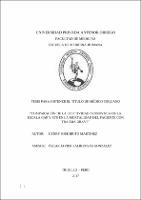Mostrar el registro sencillo del ítem
Comparacion de la efectividad pronostica de la escala gap y rts en la mortalidad del paciente con trauma grave
| dc.contributor.advisor | Salirrosas Gonzalez Oscar Javier | |
| dc.contributor.author | Brito Martinez, Henry Jose | |
| dc.creator | Brito Martinez, Henry Jose | |
| dc.date.accessioned | 2017-05-08T20:24:45Z | |
| dc.date.available | 2017-05-08T20:24:45Z | |
| dc.date.issued | 2017 | |
| dc.identifier | T_MED_1991 | |
| dc.identifier.uri | https://hdl.handle.net/20.500.12759/2586 | |
| dc.description.abstract | Determinar la efectividad pronóstica de los scores GAP y RTS en la mortalidad del paciente con trauma grave. Método: Estudio clínico observacional, tipo estudio pronóstico. Se incluyó 118 pacientes con trauma grave atendidos en el Servicio de Emergencia de Trauma del Hospital Regional Docente de Trujillo durante 12 meses. Se registraron los datos de filiación, mecanismo de producción del trauma; se catalogó el grado de lesión ocasionado por el trauma a través de la New Injury Severity Scale (NISS), las constantes vitales, el cálculo del puntaje de la escala Revised Trauma Score (RTS) y de la Glasgow come scale, Age, and Systolic Blood Presure (GAP) y la condición de alta del servicio. Resultados: El score RTS presentó una sensibilidad de 81%, una especificidad de 62%, un VPP de 93% y un VPN de 34%. El score GAP presentó una sensibilidad de 61%, una especificidad de 87%, un VPP de 96% y un VPN de 25%. En el cálculo de la precisión pronóstica, el score RTS mostrò un área bajo la curva ROC de 80 %, mientras que el score GAP mostrò 82%. Conclusiones: El score GAP obtuvo una mayor sensibilidad, pero menor especificidad que el score RTS. El GAP mostró VPP y VPN mayores que el RTS. Ambos scores son igual de eficaces para predecir la mortalidad de los pacientes con trauma grave. | es_PE |
| dc.description.abstract | To determine the prognostic effectiveness of GAP and RTS scores in the mortality of patients with major trauma. Methods: Observational clinical study, like prognostic study. We included 118 patients with major trauma treated at the Trauma Emergency Service of the Hospital Regional Docente de Trujillo for 12 months. The data of affiliation, trauma production mechanism were registered; the degree of injury caused by the trauma was recorded through the New Injury Severity Scale (NISS), the vital constants, the calculation of the score of the Revised Trauma Score (RTS) and the Glasgow come scale, Age, and Systolic Blood Presure (GAP) and the state of the discharged patient. Results: The RTS score had a sensitivity of 81%, a specificity of 62%, a PPV of 93% and a NPV of 34%. The GAP score had a sensitivity of 61%, a specificity of 87%, a PPV of 96% and a NPV of 25%. In the calculation of prognostic accuracy, the RTS score showed an area under the ROC curve of 80%, while the GAP score showed 82%. Conclusions: The GAP score obtained higher sensitivity, but lower specificity than the RTS score. GAP showed PPV and NPV greater than RTS. Both scores are equally effective in predicting the mortality of patients with severe trauma. | en_US |
| dc.format | application/pdf | |
| dc.language.iso | spa | es_PE |
| dc.publisher | Universidad Privada Antenor Orrego | es_PE |
| dc.relation.ispartofseries | T_MED_1991 | |
| dc.rights | info:eu-repo/semantics/openAccess | es_PE |
| dc.rights.uri | https://creativecommons.org/licenses/by/4.0/ | |
| dc.source | Universidad Privada Antenor Orrego | es_PE |
| dc.source | Repositorio Institucional - UPAO | es_PE |
| dc.subject | Trauma Grave | es_PE |
| dc.subject | Score RTS | es_PE |
| dc.title | Comparacion de la efectividad pronostica de la escala gap y rts en la mortalidad del paciente con trauma grave | es_PE |
| dc.type | info:eu-repo/semantics/bachelorThesis | es_PE |
| thesis.degree.level | Título Profesional | es_PE |
| thesis.degree.grantor | Universidad Privada Antenor Orrego. Facultad de Medicina Humana | es_PE |
| thesis.degree.name | Médico Cirujano | es_PE |
| thesis.degree.discipline | Medicina Humana | es_PE |
| dc.publisher.country | PE |
Ficheros en el ítem
Este ítem aparece en la(s) siguiente(s) colección(es)
-
Medicina Humana [2783]


